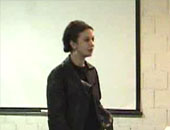« Workshop's result: Lunatic Room | Main | Works & Projects presentation by Rachel Wingfield »
11. 12. 2006 17:15 | 04_Workshop_5 , 12_Curated_posts
"Language of Pattern" a workshop by Rachel Wingfield
Ar&D, 2nd and 3rd year MID students Workshop with Rachel Wingfield
Monday 27th November to Friday 1st December 2006

Brief workshop presentation by Rachel Wingfield
ecal 27th Nov 2006 - 40min (flash8 video)
Introduction
The aim of this one-week project is for you to explore and challenge your interpretation of pattern in the environment. It is an opportunity to consider the natural environment and design scenarios that synchronise technology with temporal patterns within nature. The workshop will question the deeper meanings of decoration and ornamentation as well as highlight the importance of a craft discipline.
Context:
Nature
Nature is a vast source of ideas to learn, understand and be inspired by, rather than a source of materials to be extracted, converted then discarded. A new design agenda can be realised through developing environmental wisdom, cooperating with nature rather than working towards its extermination.
We can experience the cycles and signs of our natural environment on every sensory level from the change in humidity and atmospheric pressure to the fragrance and vision of flowering plants. As urban, built landscapes consume a natural ecology it becomes increasingly difficult to read these signs. Looking at Nature in this way it can be seen as the prime example of an ambient display.
Ambient displays or devices can be understood within the context of computation with ubiquitous and pervasive computing, and is based on the ability of the brain to perceive information and pattern at an apparently low cognitive level. An example being the project by Loop.pH called Buried Light where wallpaper is used as a patterned interface that visually communicates domestic energy consumption.
Textiles & technology
The proliferation of textiles has historically played a significant role in the development of technology and today the relationship between the two is ever more important. Miniaturisation of technology allows wireless communication devices, microprocessors and sensors to be embedded into everyday textiles and familiar objects.
Through a wide range of emergent technologies, the process of ‘making’ in the creative field is becoming increasingly virtual and mechanized with the limitations of computation often overlooked. No computed simulation works identically to physical materials. Textiles are deeply rooted in a craft discipline where extensive ‘hands on’ training and knowledge of materials are often passed down through generations. Technology and computation should be viewed as simply another set of materials to be skillfully manipulated in a similar way to the more familiar textiles, yarns and filaments.
An integral part of the textile discipline is pattern both structurally and in the context of ornamentation and decoration. It is also a principle deeply embedded in the natural world. The human brain is finely attuned to recognising pattern and is built upon the notion of familiarity and evolution. The universe can be understood as a shared and interconnected pattern.
Part 1.
To prepare for initial meeting on Monday afternoon (27 Nov)
1. Bring a collection of images (minimum 6) that demonstrates the proliferation and ubiquity of textiles.
2. Start thinking about natural phenomena and how patterns can be perceived and understood in cycles of time. Research and identify a minimum of two different and specific natural cycles based on Biology and an area of science called phenology – a study of the times of recurring natural phenomena. A broad example being the response of living organisms to seasonal and climatic changes in their environment, such as the migration patterns of birds and floral blooms in spring.
Part 2.
Design a scenario for a time based ambient display based on a chosen natural cycle using textiles and surfaces as the interface. The textile should express and work in synergy with the environment. It could be an architectural intervention, an object, or a collection of interconnected textiles within a chosen context. Your environment could be domestic, public or natural – this is very much up to you. Consider how decoration and ornamentation is currently used in the built
environment, as this could be a starting point to expand upon. Pattern should be used as the principle tool to recognise and apply interconnectedness with environmental wisdom.
Create a narrative through the use of sketches, models, animation or film that informs the audience as to how a textile/object could reconcile humans with the natural environment. Question how technology and man made interventions can be used to extend this relationship. This should be presented to the group on Friday the 1st December.
By the end of the workshop you should have the beginnings of a design proposal and a developed research question that you may wish to explore further. Consider the following quote by the German artist Hans Haacke as inspiration for your scenario development. He is referring to his chosen material of living plant matter.
make something which experiences, reacts to its environment, changes, is non-stable...
... make something indeterminate, which always looks different, the shape of which cannot be predicted precisely...
... make something which cannot 'perform' without the assistance of its environment...
... make something which reacts to light and temperature changes, is subject to air currents and whose function depends on the forces of gravity...
... make something which the 'viewer' handles, with which he plays and thus animates...
... make something which lives in time and makes the 'viewer' experience time...
... articulate something natural...
Hans Haacke, Cologne, 1965
Posted by |BRAM| at 11. 12. 2006 17:15